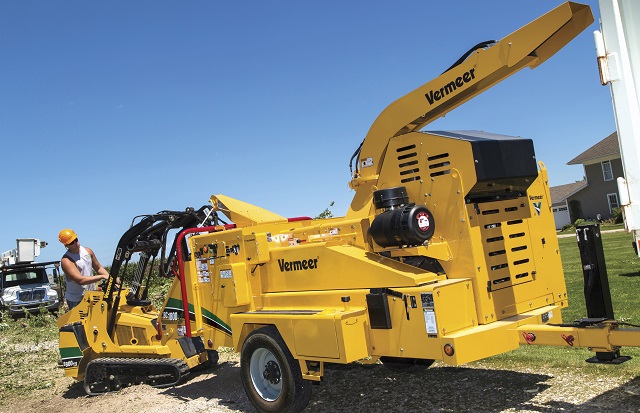Whether contractors are purchasing a brush chipper to add a new service offering or just to upgrade their fleet, the investment deserves careful consideration. In order to select the right size brush chipper, contractors need to examine their local markets and determine whether it makes sense to offer tree trimming or takedown services.
“Customers who are looking to purchase their first brush chipper should consider what type of business they want to be doing,” said Todd Roorda, tree care, rental and landscape sales manager at Vermeer. “Are you going to be trimming trees or specializing in takedowns? Those are two completely different tasks that may require different brush chipper sizes and features.”
Chipping capacity considerations
A contractor looking to specialize in tree trimming should consider a smaller brush chipper. Contractors performing land-clearing work involving tree takedowns will generally need a larger unit.
Contractors should also consider their local landscapes. Will most jobs be in newer, residential areas with young trees that are smaller in diameter or in established developments with larger, more mature trees?
“If the chipper is too small, contractors are going to spend more time maneuvering the material and hauling wood off to other companies’ sites, so that it can be chipped and prepared for dumping,” said Roorda. “Because most dumpsites no longer accept whole trees and large logs, a contractor with a brush chipper that’s too small will likely incur higher tipping fees.”
On the other hand, if you have an 18- or 21-inch (45.7 or 53.3 cm) capacity brush chipper and you’re only chipping 6-inch (15.2 cm) material, you’re wasting fuel running a chipper that’s larger than necessary.
“If a contractor upgrades to a bigger machine, he may have to get a larger truck — and there probably will be additional fuel costs associated with not only the truck, but also the chipper,” Roorda said. “Larger chippers have more horsepower, and more horsepower takes more fuel.”
That’s why it is important to right-size your brush chipper to help minimize the cost of operation.
Roorda says a good rule of thumb is to purchase a chipper that can handle at least 80 to 90 percent of the tree and brush a contractor intends to chip. For example, if a tree service provider plans to process trees where the bulk of the material is 12- to 18-inches (30.4 to 45.7 cm) in diameter, then an 18-inch (45.7 cm) capacity brush chipper would be sufficient.
Contact your local Vermeer dealer for help determining which size brush chipper is right for your tree care business.
